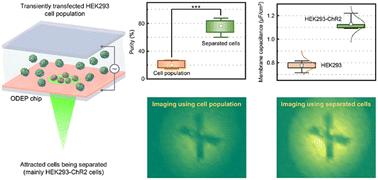Our official English website, www.x-mol.net, welcomes your feedback! (Note: you will need to create a separate account there.)
Label-free purification and characterization of optogenetically engineered cells using optically-induced dielectrophoresis
Lab on a Chip ( IF 6.1 ) Pub Date : 2022-07-25 , DOI: 10.1039/d2lc00512c Jia Yang 1, 2, 3 , Yanyu Gu 1, 2, 4 , Chuang Zhang 1, 2 , Yuzhao Zhang 1, 2, 3 , Wenfeng Liang 5 , Lina Hao 4 , Ying Zhao 6 , Lianqing Liu 1, 2 , Wenxue Wang 1, 2
Lab on a Chip ( IF 6.1 ) Pub Date : 2022-07-25 , DOI: 10.1039/d2lc00512c Jia Yang 1, 2, 3 , Yanyu Gu 1, 2, 4 , Chuang Zhang 1, 2 , Yuzhao Zhang 1, 2, 3 , Wenfeng Liang 5 , Lina Hao 4 , Ying Zhao 6 , Lianqing Liu 1, 2 , Wenxue Wang 1, 2
Affiliation

|
Optogenetically engineered cell population obtained by heterogeneous gene expression plays a vital role in life science, medicine, and biohybrid robotics, and purification and characterization are essential to enhance its application performance. However, the existing cell purification methods suffer from complex sample preparation or inevitable damage and pollution. The efficient and nondestructive label-free purification and characterization of the optogenetically engineered cells, HEK293-ChR2 cells, is provided here using an optically-induced dielectrophoresis (ODEP)-based approach. The distinctive crossover frequencies of the engineered cells and the unmodified cells enable effective separation due to the opposite DEP forces on them. The ODEP-based approach can greatly improve the purity of the separated cell population and especially, the ratio of the engineered cells in the separated cell population can be enhanced by 275% at a low transfection rate. The size and the membrane capacitance of the separated cell population decreases and increases, respectively, as the ratio of the engineered cells grows in the cell population, indicating that successful expression of ChR2 in a single HEK293 cell makes its size and membrane capacitance smaller and larger, respectively. The results of biohybrid imaging with the optogenetically engineered cells demonstrated that cell purification can improve the imaging quality. This work proves that the separation and purification of engineered cells are of great significance for their application in practice.
中文翻译:

使用光诱导介电泳对光基因工程细胞进行无标记纯化和表征
通过异质基因表达获得的光基因工程细胞群在生命科学、医学和生物混合机器人技术中发挥着至关重要的作用,纯化和表征对于提高其应用性能至关重要。然而,现有的细胞纯化方法存在样品制备复杂或不可避免的损坏和污染的问题。此处使用基于光诱导介电泳 (ODEP) 的方法提供了光基因工程细胞 HEK293-ChR2 细胞的高效和无损无标记纯化和表征。工程细胞和未修饰细胞的独特交叉频率能够有效分离,因为它们受到相反的 DEP 力。基于 ODEP 的方法可以大大提高分离细胞群的纯度,尤其是,在低转染率的情况下,分离细胞群中工程细胞的比例可提高275%。随着工程细胞在细胞群中的比例增加,分离的细胞群的大小和膜电容分别减小和增加,表明 ChR2 在单个 HEK293 细胞中的成功表达使其大小和膜电容越来越小, 分别。光基因工程细胞的生物杂交成像结果表明,细胞纯化可以提高成像质量。这项工作证明了工程细胞的分离纯化对其在实践中的应用具有重要意义。随着工程细胞在细胞群中的比例增加,分离的细胞群的大小和膜电容分别减小和增加,表明 ChR2 在单个 HEK293 细胞中的成功表达使其大小和膜电容越来越小, 分别。光基因工程细胞的生物杂交成像结果表明,细胞纯化可以提高成像质量。这项工作证明了工程细胞的分离纯化对其在实践中的应用具有重要意义。随着工程细胞在细胞群中的比例增加,分离的细胞群的大小和膜电容分别减小和增加,表明 ChR2 在单个 HEK293 细胞中的成功表达使其大小和膜电容越来越小, 分别。光基因工程细胞的生物杂交成像结果表明,细胞纯化可以提高成像质量。这项工作证明了工程细胞的分离纯化对其在实践中的应用具有重要意义。表明 ChR2 在单个 HEK293 细胞中的成功表达使其大小和膜电容分别越来越小。光基因工程细胞的生物杂交成像结果表明,细胞纯化可以提高成像质量。这项工作证明了工程细胞的分离纯化对其在实践中的应用具有重要意义。表明 ChR2 在单个 HEK293 细胞中的成功表达使其大小和膜电容分别越来越小。光基因工程细胞的生物杂交成像结果表明,细胞纯化可以提高成像质量。这项工作证明了工程细胞的分离纯化对其在实践中的应用具有重要意义。
更新日期:2022-07-29
中文翻译:

使用光诱导介电泳对光基因工程细胞进行无标记纯化和表征
通过异质基因表达获得的光基因工程细胞群在生命科学、医学和生物混合机器人技术中发挥着至关重要的作用,纯化和表征对于提高其应用性能至关重要。然而,现有的细胞纯化方法存在样品制备复杂或不可避免的损坏和污染的问题。此处使用基于光诱导介电泳 (ODEP) 的方法提供了光基因工程细胞 HEK293-ChR2 细胞的高效和无损无标记纯化和表征。工程细胞和未修饰细胞的独特交叉频率能够有效分离,因为它们受到相反的 DEP 力。基于 ODEP 的方法可以大大提高分离细胞群的纯度,尤其是,在低转染率的情况下,分离细胞群中工程细胞的比例可提高275%。随着工程细胞在细胞群中的比例增加,分离的细胞群的大小和膜电容分别减小和增加,表明 ChR2 在单个 HEK293 细胞中的成功表达使其大小和膜电容越来越小, 分别。光基因工程细胞的生物杂交成像结果表明,细胞纯化可以提高成像质量。这项工作证明了工程细胞的分离纯化对其在实践中的应用具有重要意义。随着工程细胞在细胞群中的比例增加,分离的细胞群的大小和膜电容分别减小和增加,表明 ChR2 在单个 HEK293 细胞中的成功表达使其大小和膜电容越来越小, 分别。光基因工程细胞的生物杂交成像结果表明,细胞纯化可以提高成像质量。这项工作证明了工程细胞的分离纯化对其在实践中的应用具有重要意义。随着工程细胞在细胞群中的比例增加,分离的细胞群的大小和膜电容分别减小和增加,表明 ChR2 在单个 HEK293 细胞中的成功表达使其大小和膜电容越来越小, 分别。光基因工程细胞的生物杂交成像结果表明,细胞纯化可以提高成像质量。这项工作证明了工程细胞的分离纯化对其在实践中的应用具有重要意义。表明 ChR2 在单个 HEK293 细胞中的成功表达使其大小和膜电容分别越来越小。光基因工程细胞的生物杂交成像结果表明,细胞纯化可以提高成像质量。这项工作证明了工程细胞的分离纯化对其在实践中的应用具有重要意义。表明 ChR2 在单个 HEK293 细胞中的成功表达使其大小和膜电容分别越来越小。光基因工程细胞的生物杂交成像结果表明,细胞纯化可以提高成像质量。这项工作证明了工程细胞的分离纯化对其在实践中的应用具有重要意义。



























 京公网安备 11010802027423号
京公网安备 11010802027423号